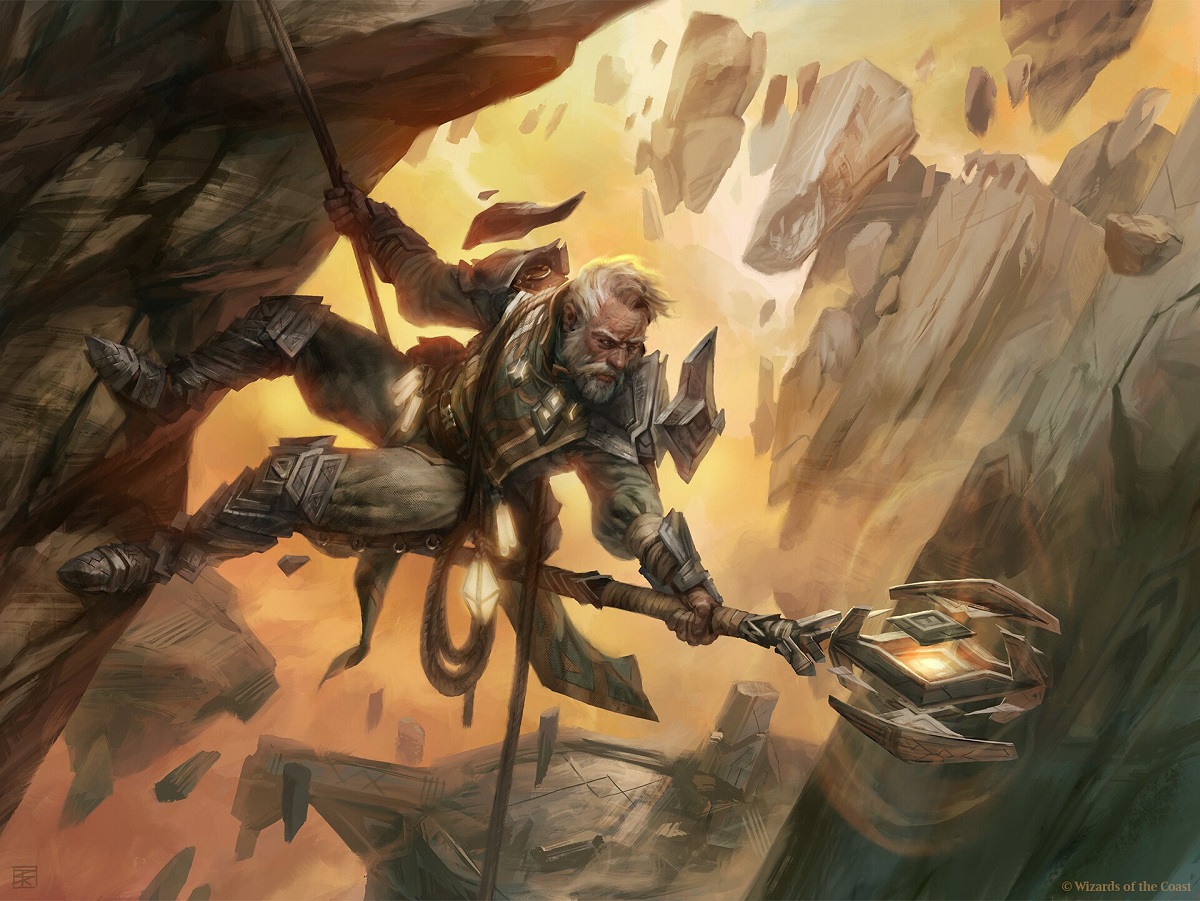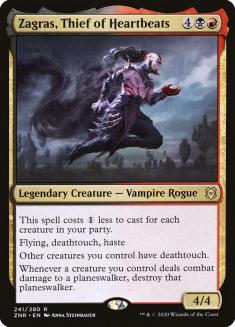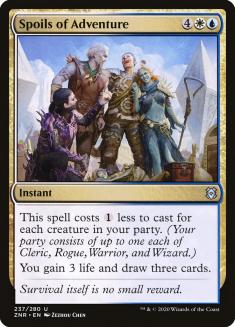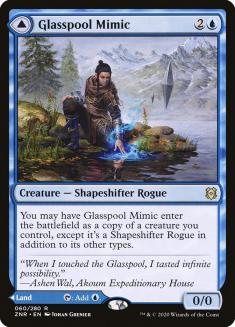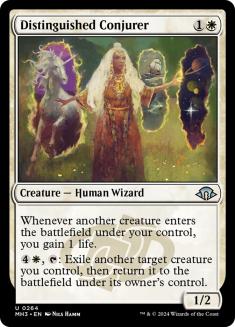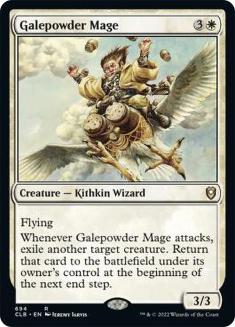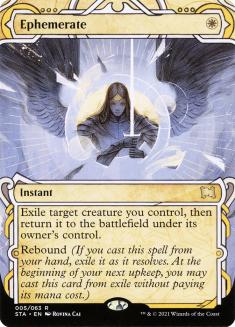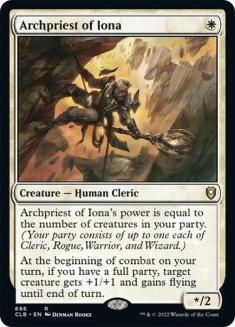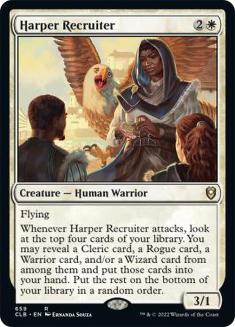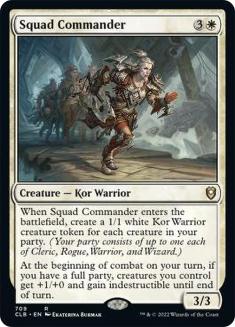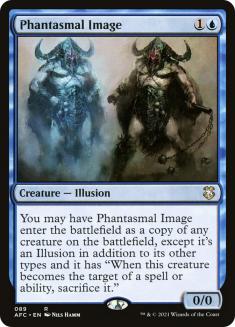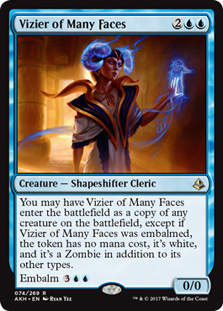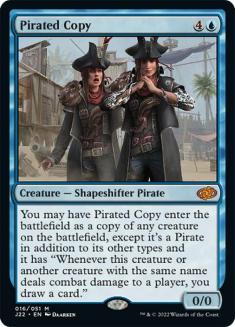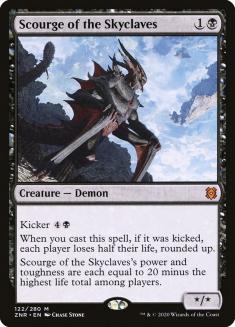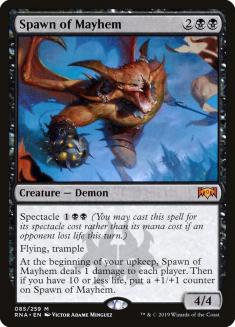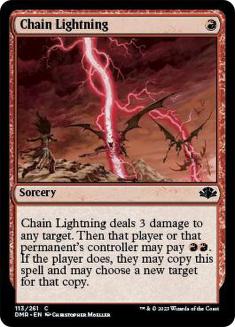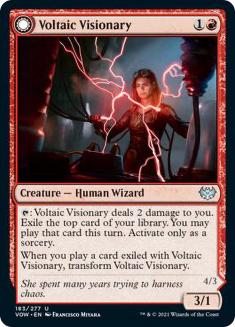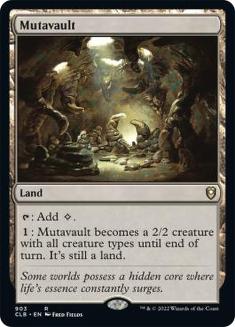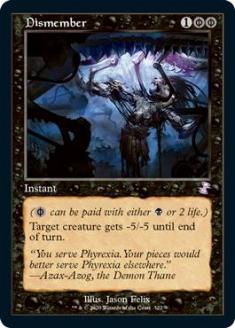It feels like I’ve been waiting forever for spring, and I’m so grateful that it’s finally here! Something that I’ve been waiting even longer for was assembling a Cube centered around the party mechanic that I found satisfying. As I teased last week, I’ve finally found a way to make that project work! It’s not a Cube exactly, but this week I’ll be sharing my Party Jumpstart Kit with some more insights on how to approach designing your own such environment!
Last week served as sufficient preamble for the list, so I’ll just go ahead and drop the Cube Cobra link for the kit now. I used tags to separate everything so that each packet displays individually. This was honestly really tedious, and I probably would just use a spreadsheet if I were to start a new Jumpstart project in the future. Each packet consists of the cards listed, plus six of the appropriate basic lands and one Thriving land. Now I’ll offer a couple more notes on this design broadly before breaking everything down by color.
Mono-Color Packets
Last week, I went over the possibility of building packets of two or more colors, but all packets in my kit are mono-color. The reason for this is that even if you do build two-color packets with fetchlands, shocklands, and dual lands, you still run into trouble when you end up with a four-color combination. Polluted Delta can’t fetch Temple Garden, after all. There are more involved ways to address this issue, or just to accept it as part of the variance of this play style, but my preference here is to keep things simple and functional.
This does mean that my build eschews a few of the more appealing party cards. Zagras, Thief of Heartbeats is on the sidelines by default, and I do think about ways to fit Spoils of Adventure in now and again, but this model that necessitates their inclusion functions smoothly and easily as is.
Singleton Across All Packets
Except for Thriving lands, I kept this design singleton. Part of my reasoning for this is that I just enjoy the puzzle of assembling singleton environments more than using multiples. Another part is that this gives the individual packets more identity. Perhaps the most significant reason that I kept things singleton though is that there are a lot of cards here that every packet of a color would want to play, and with the variance of mixing packets I’m not trying to meticulously balance the gameplay. The environment just feels a lot more engaging with this restriction.
Maintaining singleton also just makes the games much more varied. Different packets offer different incentives for developing the battlefield and different ways to make use of their own removal spells. Breaks in singleton start to homogenize these play patterns and diminish the charm of the environment. Some of that is because of the party theme across my kit, though, and small breaks in singleton, especially in kits with more total packets, can be useful or even necessary at some point.
Special Lands
When I was first mapping out my list, I paused when thinking about how to use Glasspool Mimic. Modal double-faced cards (MDFCs) are, interesting with regard to whether you count them as a land or a spell, and with each packet having eight total lands that meant the decks would be one shy of the typically desired seventeen. I spent a little time considering giving each packet a different MDFC, but some just fit much better than others.
Ultimately, I landed on just living with the sixteen-land model and cutting a basic from every packet for a special land of some kind. Many of these lands are MDFCs, which help those packets mitigate flood, while other packets have widely varying utility in this slot. This is a fun way to give each packet a little more identity, though it does become progressively more difficult to find cards for these slots as you add more packets.
The Party Packets
It’s likely that I’ve spent more time on Scryfall looking at creatures with party types and changelings than anyone else. Something you notice pretty quickly is that none of the five colors give you a long list for all four of the relevant creature types, especially if you care about any kind of mechanical coherency otherwise.
I initially addressed this by making packets that had completely different themes, but this led to more pronounced issues with power level, while also making the party theme generally fall flat. I originally had party cards and changelings distributed in the packets that focused on specific creature types, but once my initial design missed my vision, I made the decision to give each color a focused Party packet and to find a way to make three of the four party types work independently. This was much easier to accomplish with some colors than others. Let’s go ahead and get into that.
White
White has very deep options for Warriors and Clerics, though notably doesn’t offer any Rogues- or Wizards-matter cards. My initial design had blink and generic lifegain as the other two white packets, with lifegain being mostly boring redundancy with the white Cleric packet. The Blink packet was far more salvageable, though, and elements of it are maintained in the current design.
There was just kind of enough stuff to make a Wizard packet with a blink theme, which I really fell in love with as I designed it. Each color does Wizards a little differently, and that does a lot to increase the range of things that can happen in games in this environment.
When it comes to the Party packets, I just find the most appropriate creatures of the remaining party type and load the packet up with cards that care about party, changelings, and leftovers from the other three party types. White is pretty long on good party cards, which made it one of the easier colors to actually assemble four packets for.
Blue
Blue has nice options for Wizards and Rogues, but notably it doesn’t do much at all with Warriors, Clerics, or the party mechanic! One of the packets in my original design was just called “Clones” and it was really fun and funny to play with. It was literally all creatures that copied other creatures, with Rite of Replication and Quasiduplicate as its noncreature spells. This packet was basically split as the starting point for blue’s Warrior and Party packets.
Those packets do still admittedly feature some pretty weak cards. Proven Combatant and Seafloor Stalker are both near the bottom of power levels for individual cards in the kit. I counterbalanced this with the strength of some of the Clone options, as well as giving these packets some generically powerful noncreature spells. The clones are really the glue here, and they can lead to some really wacky and powerful stuff when combined with or against packets with more individually powerful creatures.
The blue Wizard packet also went through an interesting evolution. I liked the idea of packets featuring some kind of mini-game, which in theory could be an alternate win condition. This packet initially featured Thassa’s Oracle, which ultimately just didn’t strike me as fun, but it was totally broken in conjunction with Azami, Lady of Scrolls. I love Azami, but the card is just way better than anything else going on in this environment, which was too bad. I ended up pivoting to a different sort of mini-game, which is trying to get value out of Naban, Dean of Iteration.
Black
Black has good Warriors, good Clerics, good Rogues, good cards that care about the party mechanic, and even a couple of good Wizards! There’s not really a ton to say about the design for black, and I think the four black packets speak for themselves better than any other color. I suppose it’s worth sharing a little bit about the evolution of the design, though.
The party cards were initially spread across the Cleric, Rogue, and Warrior packets, given that my original design allowed for the exploration of some non-party themes. The fourth black packet had a Death’s Shadow theme, which I estimated was going to be kind of difficult to pull off, but actually ended up being a little too powerful. Free removal spells like Snuff Out and bigger creatures than the other packets realistically had access to were a little too much for this environment to bear! It’s definitely one that I’ll keep in mind if I ever explore a Jumpstart environment without a unifying central theme, though.
That packet also featured Dark Confidant, which enjoyed a short stay in the Party packet as black’s best Wizard. Dark Confidant is a little too much of a must-answer and the expensive party cards also make him quite a liability, and I landed on its inclusion being inappropriate here. This was by far the most painful cut from the kit for me.
Red
Red has a great cast of Warriors and Wizards, but Rogues leave something to be desired and Clerics are close to nonexistent. It was obvious that the red Party packet would be Clerics, but figuring out Rogues took some effort.
There are a couple of neat mini-games in the Rogue packet. Humble Defector is a cool card that gets dramatically better if you can sacrifice it with the ability on the stack, and Laurine, the Diversion is a compelling card in combat-centric environments that also offers a sacrifice outlet. The guessing game with morphs in Jeering Instigator and Fortune Thief is pretty fun, too.
I hemmed and hawed quite a bit about Robber of the Rich. I’ve come to really hate cards that let you play off the opponent’s deck in 40-card environments, but Robber is very blockable and is the only red card that actually offers any semblance of Rogue synergies.
The red Party packet is pretty wild. It offers some explosive potential with Priest of Urabrask and Ardent Electromancer, but ultimately a lot of what’s available here are just creatures that can attack and block that aren’t all that powerful. I subsidized the power level here by giving this packet the best of the best burn spells in Lightning Bolt and Chain Lightning. I have mixed feelings about Voltaic Visionary for transforming into a non-party creature, but the gameplay considerations there in terms of assembling a full party are interesting enough for it to have a slot for now.
Green
Green was by far the most difficult color to get four party-relevant packets for, with Warriors being the only creature type with any meaningful representation. This meant that green was going to need all the colorless changeling and “choose a creature type” cards to really make it function here. I had to dig pretty deep to make green work, but I’m reasonably happy with where I ended up.
I’ll be anxiously awaiting any and all green Wizards, Clerics, and Rogues, but the packets I currently have do function and have some cool stuff going on. Gladewalker Ritualist is kind of a silly card for a singleton environment, but a three-mana 3/3 isn’t the worst in terms of relative size here, and it is an enticing option for the blue Clones.
Green has a couple of creatures that count as each party type, which is nice, but Strength of Solidarity is an awkward party payoff. I made the special land in the green Party packet Mutavault to increase the power level some, though this does come at some detriment to the packet’s ability to produce green mana. This can be addressed with the option I suggested last week to swap out one spell from a deck for a basic land of your choice.
The other loudly cheeky decision I made in green was to give the Wizard packet Dismember. Wizards cast spells, and there just aren’t that many good green ones! Some of the other cards in that packet are… questionable, so the power level of Dismember helps to balance things out.
Get This Party Jumpstarted
I’ve been having an absolute blast playing with my Jumpstart Kit. A good amount of work goes into designing and assembling these kits, but the games are really fun and fast-paced, so you can play a lot of them. That’s always a huge plus for me, and makes Jumpstart a perfect supplement to any Cube night, activity between rounds at events, or something totally worth just playing as its own thing.

